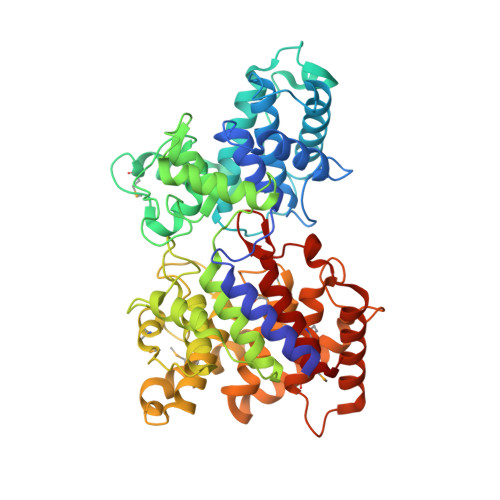Structure of the ent-Copalyl Diphosphate Synthase PtmT2 from Streptomyces platensis CB00739, a Bacterial Type II Diterpene Synthase.
Rudolf, J.D., Dong, L.B., Cao, H., Hatzos-Skintges, C., Osipiuk, J., Endres, M., Chang, C.Y., Ma, M., Babnigg, G., Joachimiak, A., Phillips, G.N., Shen, B.(2016) J Am Chem Soc 138: 10905-10915
- PubMed: 27490479
- DOI: https://doi.org/10.1021/jacs.6b04317
- Primary Citation of Related Structures:
5BP8 - PubMed Abstract:
Terpenoids are the largest and most structurally diverse family of natural products found in nature, yet their presence in bacteria is underappreciated. The carbon skeletons of terpenoids are generated through carbocation-dependent cyclization cascades catalyzed by terpene synthases (TSs). Type I and type II TSs initiate cyclization via diphosphate ionization and protonation, respectively, and protein structures of both types are known. Most plant diterpene synthases (DTSs) possess three α-helical domains (αβγ), which are thought to have arisen from the fusion of discrete, ancestral bacterial type I TSs (α) and type II TSs (βγ). Type II DTSs of bacterial origin, of which there are no structurally characterized members, are a missing piece in the structural evolution of TSs. Here, we report the first crystal structure of a type II DTS from bacteria. PtmT2 from Streptomyces platensis CB00739 was verified as an ent-copalyl diphosphate synthase involved in the biosynthesis of platensimycin and platencin. The crystal structure of PtmT2 was solved at a resolution of 1.80 Å, and docking studies suggest the catalytically active conformation of geranylgeranyl diphosphate (GGPP). Site-directed mutagenesis confirmed residues involved in binding the diphosphate moiety of GGPP and identified DxxxxE as a potential Mg(2+)-binding motif for type II DTSs of bacterial origin. Finally, both the shape and physicochemical properties of the active sites are responsible for determining specific catalytic outcomes of TSs. The structure of PtmT2 fundamentally advances the knowledge of bacterial TSs, their mechanisms, and their role in the evolution of TSs.
Organizational Affiliation:
Department of Chemistry, The Scripps Research Institute , Jupiter, Florida 33458, United States.

















